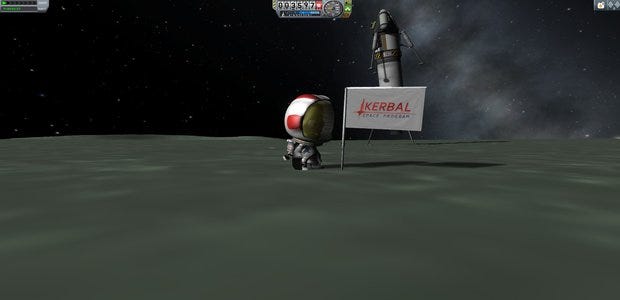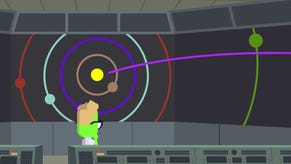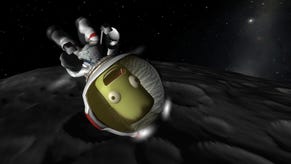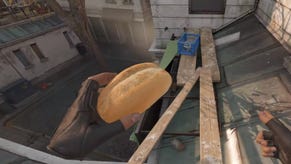Kerbal Space Program Beta: How Is it?
Better Than Ever?
Kerbal Space Program recently entered beta, marking another step towards the stars for its mixture of spaceship construction, physics simulation and space agency management. The game has advanced lightyears since its early releases, where all you got was a quick tutorial that prodded you in the right direction (up) then left you to your own devices. While sandbox mode remains available for people who just want to build rockets in a physics playground, for over a year the actual ‘game’ has been found in either career or science mode.
The latest update, ‘Beta Than Ever’, brings career mode much closer to its goal of becoming a space tycoon sim. Your base starts off as a collection of run down administrative buildings and hangars with severely limited capabilities. Rockets can only have 30 parts until you upgrade the vehicle assembly building, and have to be under a certain height and weight that goes up as you upgrade the launch pad. Even more restricting is the mission control building, only allowing you to have two active contracts at its lowest level. It’s these contracts that provide most of the structure in career mode, tasking you with objectives that normally require you to build something specialised.
I was initially impressed. In past versions, it was easy for a new player to get lost at the very start. Before you get a rough idea of a basic rocket’s capabilities, it’s hard to know how to progress. Working towards small, specific aims helps the early game, giving players something achievable to focus on: each contract rewards you with a combination of money, reputation or, most excitingly, science. Science acts as a second currency, spending it allows you to progress down a technology tree, unlocking bigger and better rockets.
After a while, however, I found most of the contracts started feeling like busywork. The two most common types of contract either ask you to explore a certain place or test a particular rocket part under certain conditions. Launching each flight with an unambitious aim gets old quickly. In fairness, some of the contracts are more complicated, like getting into orbit or much later on, rescuing stranded Kerbals. It’s a good system, but needs refinement. Those early exploration missions would be much better suited to appearing later for example, once you’ve got the tech and experience required to design space planes.
Perhaps better players than me will find designing ships for trivial tasks less time consuming, or build ships that complete several objectives at once. The low ambition of those early missions doesn't offer a gentle introduction for new players, either - it's an exciting end goal and something more experienced players will likely get a lot out of, but too challenging for budding new or even intermediate rocketeers. A few hours into a career I just ran out of money, effectively ending the game.
For me, science mode provides the best balance between structure and freedom. Money, reputation and contracts are all cut out, the only goal being to gather as much science as possible and progress along the tech tree. Experimentation is so much of what makes KSP fun, and it’s far easier to do that in science mode where there are no real consequences when everything inevitably explodes for no discernible reason. My best experiences with KSP have all come from working towards grand, overly ambitious projects, picking up bits of information along the way. One of my first attempts at a mun landing went awry when I accidentally over burned my engines trying to escape Kerbin’s orbit, sending my ship hurtling off course into an orbit around the Sun. I was about to load a save before I realised quite how much science I could gain from beaming back crew reports and the readings from my equipment. I told myself I’d come back for my stranded Kerbal one day, using the science he’d provided to mount a rescue mission. It was for the greater good.
At my level, the loop of completing a project to unlock more tech to complete a bigger project is satisfying enough, without having to worry about the business side of things. After unlocking a new tech level I’d sit back in my chair, literally rubbing my hands together while loading up the vehicle assembly bay to play with my new toys.
I do wish there was a way of picking and choosing some features from career mode though. In science mode, all your Kerbals start at the maximum level in one of three classes – pilot, engineer or scientist. In career mode they gain experience as they go on missions, unlocking new benefits over time. It provides monsters like me with an incentive not to throw innocent Kerbal lives away, which can only be a good thing.
The latest update also overhauled the rocket creation editor, cleaning up the interface and adding new tools that allow for a finer degree of control. Theoretically it allows for designs that weren’t possible with previous iterations, but the main improvements are about ease of life. That’s no small thing, given how much time you’ll spend in the editor. Using the new rotation system to put a part into place helped me solve a tilting issue that would have taken way more fiddling in the old version. It’s still a little confusing at times, but hey, you’re building a spaceship. It can’t all be simple.
I think the biggest problem the game faces at the moment is how to deal with you getting stuck. I’ve had several stretches where I just haven’t been able to progress, unable to work out what’s wrong, let alone how to fix it. There are tutorials in place, but they’re by no means complete. The answer at the moment is to go outside the game, looking up information on wikis or asking friends for help. At the same time, that’s arguably part of the fun. There’s something undeniably cool about watching a 25 minute video on advanced rocket construction and applying those principles in game. Even cooler, on a totally un-kerbal related visit to the science museum in London I (accidentally) found out that it’s more efficient to avoid using second stage engines during launch, saving them for the upper atmosphere.
KSP is at its best when it makes you feel like a real life rocket scientist; the game would lose a lot if it ever felt like it was holding your hand. Nevertheless, I think it’s worth telling the player how to do some basic things that they’ll never figure out by themselves. I can’t see anyone without a physics degree working out how to get into orbit using a gravity turn, for example.
Until that happens, KSP’s excellent modding scene can help with some things. The information provided by the Engineer mod seems so useful that it should be in the default game. Encouragingly, one day it might be – the massive range of new contracts that were introduced last update were once part of the ‘Fine Print’ mod, suggesting there might be more to come.
In the devs own words, KSP is now ‘scope complete’. Rather than adding new systems, the focus has shifted to improving existing content. That makes sense – even before the beta update, there’s been no shortage of stuff to do. With some balance tweaking and more extensive tutorials, career mode should be accessible to new players. Still, Kerbal Space Program is more than ready to be played - if you don’t mind doing a bit of research.














